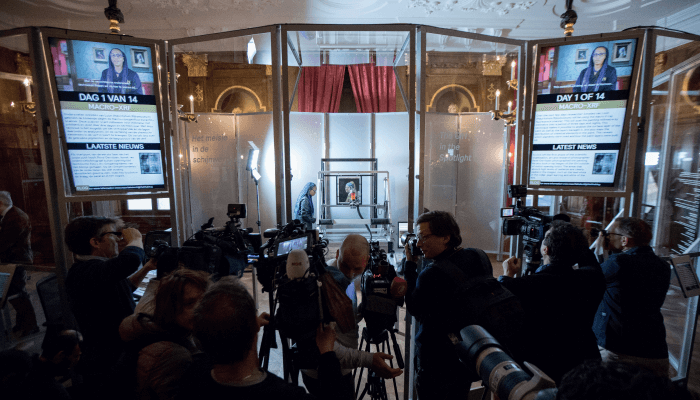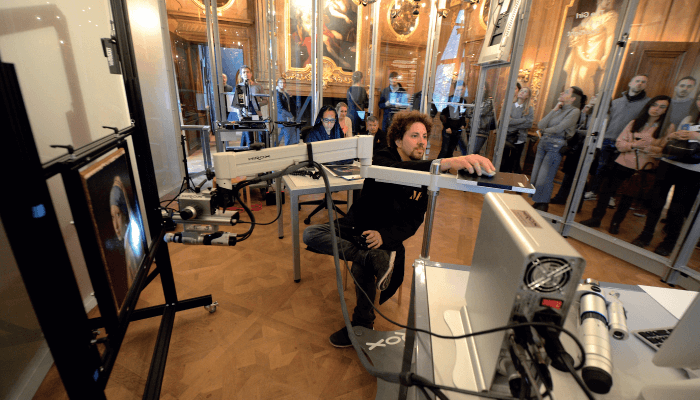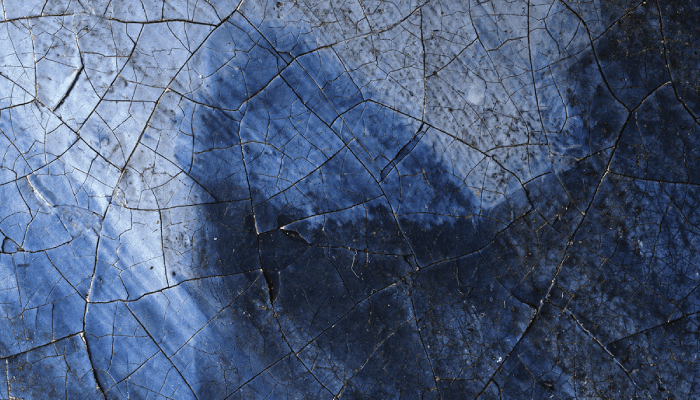
Can you tell us about yourself and the current project?
I’m a paintings conservator at the Mauritshuis in The Hague, the Netherlands. My expertise includes restoration and conservation of artworks but also, crucially, the application of advanced analytical techniques. After all, whenever we want to restore an artist’s work, we must first understand the materials and techniques the artist used. In fact, research and analysis is an increasingly important part of our work at the Mauritshuis.
Recently, Edwin Buijsen, the Head of Collections, asked me to examine one of our most iconic paintings – Girl with a Pearl Earring, which was painted by Johannes Vermeer around 1665. I couldn't believe that I was being offered such an amazing opportunity! But it also gave me a lot to think about; in addition to the usual challenges, the Mauritshuis wanted us to conduct the examination in front of museum visitors because of the painting’s high profile. We had three key questions to answer: What kind of expertise do we need for the examination? How can we access that expertise? How might we safely carry out the investigation in a public way?
And how did you approach such an important piece of artwork?
Analytical science is constantly advancing, as you well know, so we were keen to apply a suite of technologies that were simply unavailable during the last restoration – back in 1994. Indeed, one significant development over the last 25 years has been the advent of non-invasive technologies; no longer must we rely on methods that demand sample removal. For instance, we employed macro-X-ray fluorescence scanning (MA-XRF) to scan the painting’s surface and establish which elements are located in different areas. But, at the same time, we could perform more sophisticated analyses on the samples that had to be removed from the painting in 1994; for example, we were able to apply advanced elemental analysis for the first time. These techniques included scanning electron microscopy (SEM) with energy dispersive x-ray analysis (EDX), which allows us not only to identify different paint layers, but also to conduct elemental analysis of each pigment type in each layer. Another technique, focused ion beam scanning transmission electron microscopy (FIB- STEM), allows us to determine the exact elemental make-up of the tiniest particles in a thin slice of paint. We also sent some 1994 cross-sections for synchrotron analysis at a particle accelerator, which allowed us to distinguish between different types of pigment at the molecular scale. Overall, we benefited from improved versions of the technologies available in 1994 – multispectral infrared analysis, reflectance imaging spectroscopy, 3D scanning and various forms of photography. Furthermore, improvements in computing and microscopy technologies have taken us to the next level; for example, we now have a 10 billion pixel image of the Girl, which allows us to zoom in remarkably – all the way down to the level of individual pigment particles! A great deal has changed since 1994 – even the way we share results (via the Internet) was not possible back then...
All the individual technologies are exciting in their own right, but I believe the really novel aspect of our current analysis of the Girl was the holistic approach that was enabled by using so many different analytical techniques. By combining elemental identification with precise determination of element locations throughout the painting, we literally and figuratively got the full picture! Of course, this holistic approach was only made possible through collaboration with many different specialist institutions. Fortunately, conservation science is a very collaborative field, and the Girl is a very famous painting – so people were eager to help!

What novel insights did your holistic approach reveal?
In particular, by using ultra-high performance liquid chromatography (UHPLC), we established that Vermeer had used cochineal in the red of the Girl’s lips – and not just any cochineal; we showed that it was cochineal of Mexican or North American origin. In other words, he was relying on a product that must have been imported by sea. This single finding told us as much about international trade and which materials were available in Delft in the 17th century as it did about Vermeer’s choices. I think it’s amazing that we can learn so much about global-scale activity from one tiny sample.
One of our big research questions concerned the origin of Vermeer’s materials, so we were especially pleased with the cochineal finding. On a similar note, we have also been investigating lead white pigments in detail for some time. By analyzing lead white samples from artworks and historic mines all over Europe, we contributed to a database of the various types of lead white pigments and where they came from. Subsequently, we performed lead isotope analysis of the white pigment in the Girl, and compared the results with the database entries. And I can tell you that Vermeer’s lead white pigment originated in England’s Peak District – a good example of how specific we can get. This particular exercise was only made possible in this case by a micro-invasive sampling tool that was recently developed specifically for artwork analysis. The technique allowed us to remove 5 to 20 µg of pigment from a paint cross-section. Incidentally, another change we’ve seen in the last 25 years is the development of technologies specifically for the artwork analysis field!
Were you surprised by what you found?
Vermeer’s palette wasn’t exactly unexpected, as it was similar to those of his contemporaries: lead white from England, cochineal from Mexico or North America, and other locally sourced pigments. He also used indigo, but we are not yet sure of its origin. There are perhaps 800 varieties of indigo from all over the world and we don’t yet have a database that clearly defines each variety and its respective origin. We can learn more from further UHPLC-based pigment analysis – we already know that Vermeer’s pigment is not likely to have been derived from the Asian plant Indigo tinctoria – the most common form of indigo. Like the cochineal, it may be from the Americas, but we don’t yet know for sure. This indigo example illustrates the importance of pigment databases. Collaboration is key to this endeavor; fortunately, there’s a lot of interest in conservation science now, and museums are very willing to have their artworks analyzed in this way. Our databases are growing very rapidly – and that will allow us to provide more accurate and detailed analyses.
One excellent example of an unexpected finding relates to how we revealed elements of the painting that are no longer visible. For instance, the painting’s background currently appears grayish-black – but we now know that it was made up of a black charcoal underlayer beneath a glaze of blue and yellow pigments, which would originally have made an intense green. And the really new information generated by our current project is more subtle still – it turns out that the original background wasn't flat and formless, but represented the folds of a curtain! That information came from analysis using a combination of several technologies: some measured the thickness of the layers, some showed the distribution of the elements, and all together they showed us something that we had no idea existed.

How will your work guide subsequent restoration decisions?
Our analytical work not only enables us to imagine how painting looked when Vermeer painted, it also gives us a record of how it is today. By preserving a record of this painting at this moment in time, we have a reference we can use to chart any changes that might happen in the future. But we have to accept that the painting has had a rough history – it was not really appreciated until the early 20th century. For example, there are cracks in the paint surface which we just have to accept; they’re not going to get better, and they may get worse. All paintings change, whether we like it or not. But we do our best to make inevitable changes occur as slowly as possible – the painting is protected by glass, and environmental factors, such as temperature and humidity, are carefully controlled. Furthermore, we are attempting to predict changes that might happen over time, and perhaps better mitigate them.
Could your approach help establish the authorship of an artwork?
The technologies we use to identify an artist’s materials and techniques are neutral – they don’t establish authorship in themselves. But they can identify commonalities or differences between paintings, and show whether a painting of disputed provenance was produced using, say, the pigments available to the artist in question. The more analysis we do, the more confident we can be about establishing authenticity – but the aim of this project was technical examination, not establishment of authenticity.
How do you expect things to change over the next 5–10 years?
We will increasingly rely on the combination of data gathered using many different technologies. This, together with the application of data science and visualisation tools for comparative analysis, will give us unprecedented amounts of information. And I think that’s how we’ll have the greatest impact – not just by developing new technologies, but by getting more information from the data we can already generate. That’s how we approached the Girl – and the project has gone much further than many other studies. I’d like to think it will become a benchmark for future research on other paintings. But I appreciate that not every painting in every museum will be able to benefit from the range of technologies available to the Girl – the iconic nature of the piece opened many doors!
In fact, our work on the Girl is not finished – we’re still crunching data. And we are still working on a deeper exploration of how the Girl would have looked when she was first painted – for a project called “The Girl in 1665.” I’m working with scientists, academics and computer graphics specialists to reconstruct her original appearance – based on the scientific data we have gathered (it’s not just a case of tweaking some settings in Photoshop!). In brief, using digital technology, we are generating a range of possibilities of how she might have appeared in the original painting. And looking further ahead, we are investigating the possibility of using 3D-printing approaches to generate reconstructions of artworks like the Girl. It is a very exciting time!
The Girl in the Spotlight was a Mauritshuis initiative and involved a team of internationally recognised specialists associated with the Netherlands Institute for Conservation+Art+Science+ (NICAS: Rijksmuseum, TU Delft, the Cultural Heritage Agency of the Netherlands (RCE) and the University of Amsterdam), together with the University of Antwerp, Vrije Universiteit Amsterdam, Shell Technology Centre Amsterdam, Hirox Europe, the National Gallery of Art, Washington and many other partners.
A collection of ten articles about the technical examination of the Girl has been published in the open-source journal Heritage Science here.




